In the ever-evolving landscape of digital marketing, choosing the right marketing automation platform can be a game-changer for businesses. Two giants in this arena, Pardot and Marketo, have long been at the forefront, each offering a robust suite of features designed to streamline marketing processes and boost ROI. As companies increasingly rely on data-driven strategies to engage customers and drive growth, understanding the nuances between these platforms becomes crucial.
This comprehensive comparison delves into the strengths, weaknesses, and unique offerings of Pardot and Marketo. By examining their core functionalities, user experiences, and pricing models, we aim to provide clarity for businesses grappling with this critical decision. Additionally, we will introduce Prism Reach, an innovative AI-powered SaaS solution that offers a streamlined approach to email marketing analytics, providing deeper insights with ease.
Key Facts
- Pardot excels in lead management and Salesforce integration, making it ideal for B2B companies heavily invested in the Salesforce ecosystem.
- Marketo offers superior account-based marketing (ABM) capabilities and advanced analytics, catering to enterprise-level businesses with complex marketing needs.
- Both platforms provide robust email marketing tools but differ significantly in user interface complexity and pricing structures.
- Pardot’s automation rules can trigger specific actions based on lead behavior, enhancing targeted communication.
- Marketo’s Smart Campaigns allow for highly targeted campaigns based on specific criteria, automating actions based on user behavior.
- Prism Reach‘s AI-driven personalization can boost engagement rates by up to 40%, offering a cost-effective alternative to traditional email marketing tools.
Pardot vs. Marketo: Feature-by-Feature Showdown
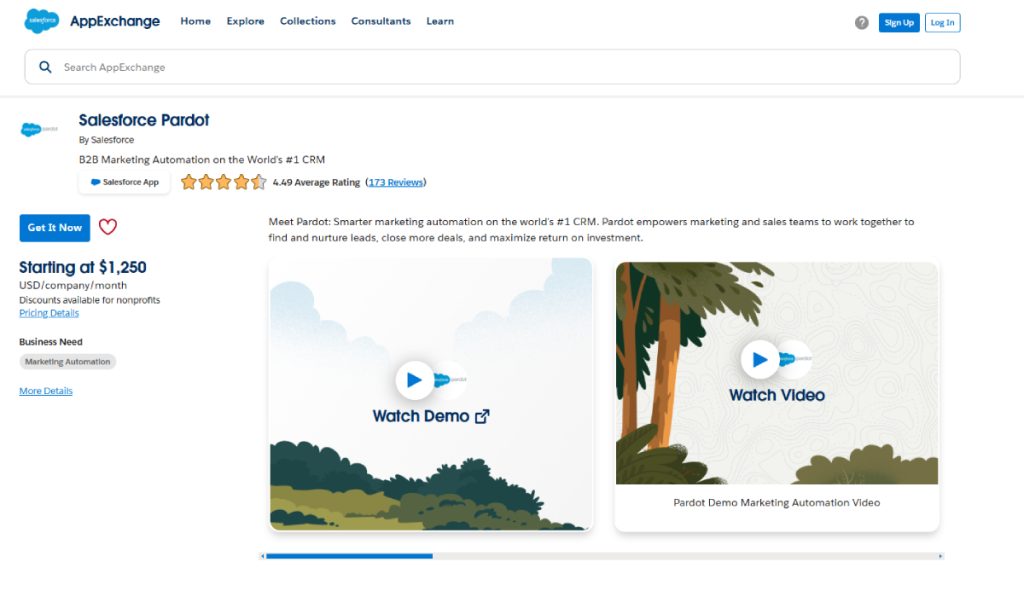
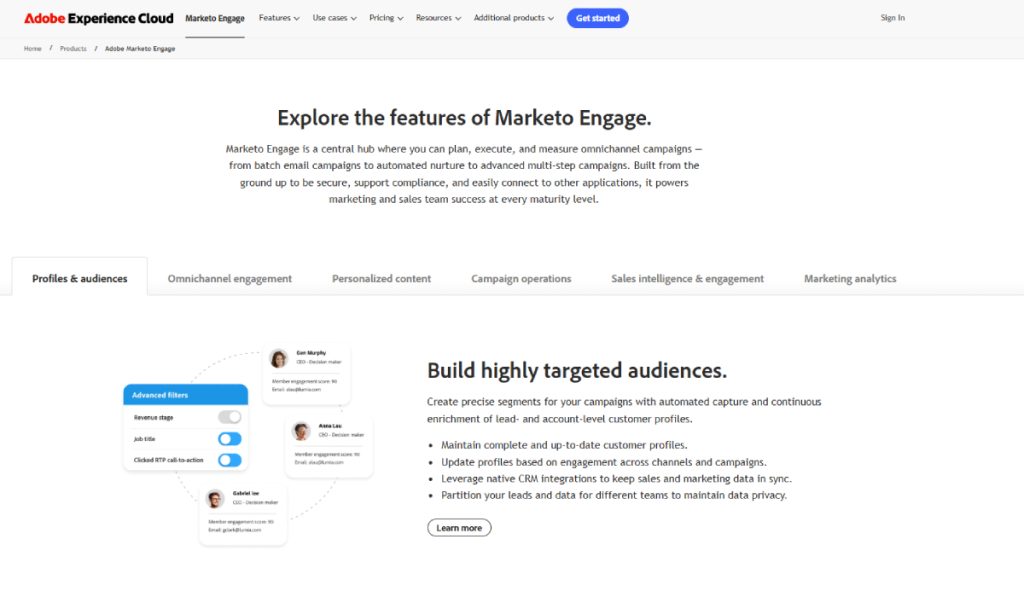
Lead Management and Nurturing
Pardot’s strength lies in its lead management capabilities, offering features like progressive profiling and automated lead scoring. These tools allow businesses to gather detailed information about prospects over time and prioritize leads based on their engagement and fit. Pardot’s Engagement Studio provides a visual, branching logic builder for designing complex, responsive journeys based on prospect behavior and attributes. This makes it easier for marketers to create sophisticated nurturing campaigns that adapt to prospect actions.
On the other hand, Marketo excels in lead nurturing with advanced, multi-touch attribution models. This provides a more nuanced view of the lead journey, allowing marketers to understand the impact of various touch points throughout the customer lifecycle. Marketo’s comprehensive lead scoring system enables precise prioritization of leads, ensuring that the most engaged and qualified prospects receive timely and relevant follow-ups.
Account-Based Marketing (ABM) and Analytics
Marketo stands out with its sophisticated capabilities, especially in account-based marketing (ABM) and advanced analytics. Its ABM features allow for the identification and targeting of key accounts with personalized messaging at scale. This is particularly valuable for B2B companies focusing on high-value accounts.
Marketo’s analytics capabilities include advanced attribution modeling and customizable dashboards, providing deep insights into marketing performance. The platform’s Revenue Cycle Modeler visualizes the customer journey and identifies bottlenecks in the sales funnel, offering a comprehensive view of the marketing and sales process. These advanced features make Marketo a favorite among larger enterprises with complex marketing needs and the technical resources to fully leverage its capabilities.
Email Marketing Capabilities
Both platforms offer robust email marketing solutions, but with different approaches. Pardot provides a drag-and-drop email builder with responsive templates, enabling personalized messaging based on prospect engagement. It also offers features like A/B testing for emails and landing pages, dynamic content capabilities, and email rendering previews across different devices and clients.
Marketo counters with sophisticated email marketing capabilities, including A/B testing, dynamic content, and predictive content selection. It also offers advanced personalization options, allowing marketers to tailor content based on user behavior and attributes. Both platforms support drip programs for lead nurturing over time and provide detailed reporting on email campaign performance. The choice between the two often depends on the level of complexity and customization required in email campaigns.
User Interface and Ease of Use
User interface and ease of use present a notable contrast between the two platforms. Pardot is known for its intuitive and user-friendly interface, making it easier for marketers to navigate and set up campaigns without extensive technical knowledge. Its drag-and-drop builders for emails and landing pages, along with pre-built templates, allow for quick campaign creation. Pardot also offers features like campaign cloning and completion actions, which streamline workflow creation.
Marketo, while powerful, features a more robust interface with a steeper learning curve. It offers extensive customization options that may require technical expertise to fully utilize. Marketo’s interface includes features like a calendar view of all marketing activities and program templates for common marketing programs, which can help streamline campaign setup for experienced users.
Pricing Models and Target Markets
Pricing is another significant differentiator between Pardot and Marketo. Pardot offers a tiered pricing model starting from $1,250 per month, making it suitable for both small and mid-sized businesses. This pricing structure includes different levels of features, allowing companies to choose a plan that fits their needs and budget. Pardot’s pricing model makes it accessible to a wider range of businesses, from growing startups to established mid-market companies.
Marketo, on the other hand, is tailored more for enterprise-level businesses. Its pricing starts at $895 per month but can quickly escalate based on features and scale. This pricing structure reflects Marketo’s focus on larger organizations with complex marketing needs and the resources to invest in a comprehensive marketing automation solution.
Integration Capabilities and Ecosystem
Integration capabilities are crucial for many businesses, and both Pardot and Marketo offer strong options in this area. Pardot’s deep, native integration with Salesforce CRM is a major selling point, facilitating seamless alignment between marketing and sales teams. This integration allows for real-time data synchronization, enabling sales teams to access up-to-date marketing information directly within Salesforce. Pardot also supports integrations with various third-party applications beyond Salesforce.
Marketo, while offering strong CRM integration options, including Salesforce and Microsoft Dynamics, provides more flexibility in this regard. It supports a wide range of third-party integrations and offers robust API access for custom integrations. This flexibility can be advantageous for companies using diverse tech stacks or requiring specialized integrations.
Integrating Hidden Gem Strategies to Enhance Marketing Automation
To navigate the strengths and weaknesses of Pardot and Marketo, integrating hidden gem strategies can significantly enhance user experience and outcomes. Here are five “hidden gem” strategies that can help users maximize the effectiveness of their marketing automation efforts with these platforms:
1. Utilize Progressive Profiling
Both Pardot and Marketo support progressive profiling, a strategy that allows you to collect more information about leads over time without overwhelming them with too many fields upfront. Instead of asking for extensive details in a single form, progressive profiling swaps out known fields for unknown ones in subsequent forms, making it easier for users to provide information and improving conversion rates.
- Enhanced User Experience: Reduces friction by asking for information incrementally, making forms less daunting.
- Improved Data Quality: Collects relevant data over time, ensuring that information is accurate and up-to-date.
- Higher Conversion Rates: Simplifies the signup process, leading to more completed forms and higher lead acquisition.
2. Leverage Smart Campaigns in Marketo
Marketo’s Smart Campaigns feature allows you to create highly targeted campaigns based on specific criteria. By using this feature, you can automate actions based on user behavior, such as sending follow-up emails after a lead downloads a resource or visits a specific page on your website. This ensures that your communication is timely and relevant, enhancing engagement and nurturing leads more effectively.
- Behavioral Triggers: Automate responses based on specific user actions to maintain engagement.
- Personalized Journeys: Create tailored email sequences for different segments, increasing relevance and effectiveness.
- Increased Efficiency: Reduce manual effort by automating repetitive tasks, allowing marketers to focus on strategy and creativity.
3. Implement Automation Rules in Pardot
Pardot’s automation rules can be set up to trigger specific actions based on lead behavior. This can include sending targeted emails or updating lead scores based on interactions, ensuring that your leads receive timely and relevant communication. Automation rules help maintain a consistent engagement strategy, even as your lead base grows.
- Automated Lead Scoring: Prioritize leads based on their engagement and interactions, focusing efforts on the most promising prospects.
- Targeted Communications: Automatically send personalized emails based on lead actions, enhancing the relevance of your messages.
- Streamlined Workflows: Create efficient workflows that adapt to lead behavior, ensuring a seamless nurturing process.
4. Use Hidden Fields for Data Capture
Both Pardot and Marketo allow the use of hidden fields in forms to capture additional data without cluttering the user interface. Use these fields to gather UTM parameters or other tracking information that can help you analyze campaign effectiveness without overwhelming users with too many form fields.
- Seamless Data Collection: Capture essential data invisibly, maintaining a clean and user-friendly form design.
- Enhanced Tracking: Collect valuable information like campaign sources and user behavior for better analysis and reporting.
- Improved Campaign Insights: Utilize hidden field data to gain deeper insights into the performance and effectiveness of your marketing campaigns.
5. Integrate with CRM Systems for Seamless Data Flow
Integrate either platform with your CRM (like Salesforce) to ensure that all lead interactions are tracked and updated in real-time. This integration allows for better lead nurturing and ensures that sales teams have access to the latest information about leads. Seamless data flow between your marketing automation platform and CRM enhances collaboration between marketing and sales, leading to more effective lead management and higher conversion rates.
- Real-Time Data Synchronization: Ensure that lead information is always up-to-date across both platforms.
- Enhanced Lead Nurturing: Use CRM data to create more targeted and effective nurturing campaigns.
- Improved Sales-Marketing Alignment: Facilitate better communication and collaboration between sales and marketing teams by sharing comprehensive lead data.
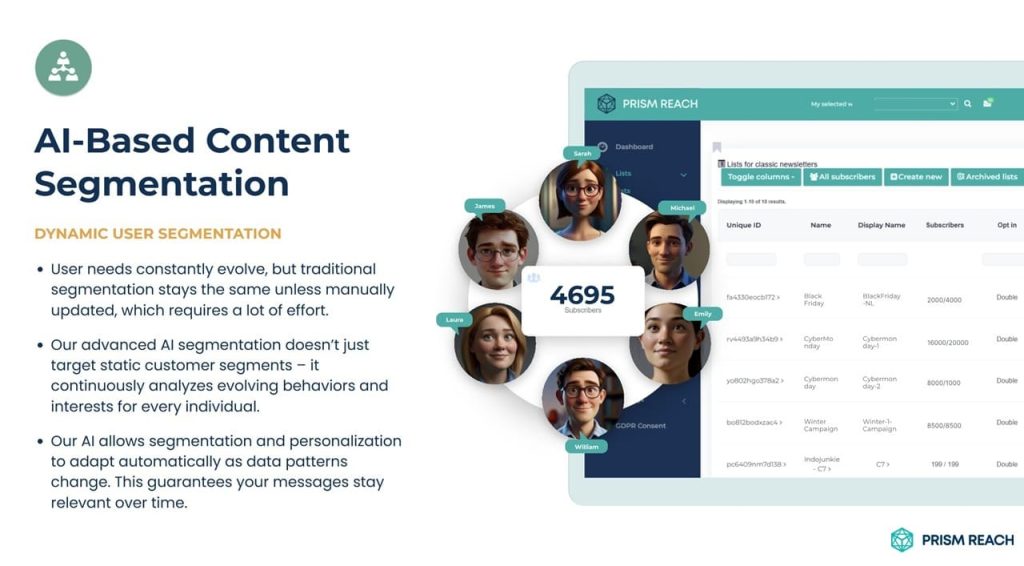
Prism Reach: Enhancing Cost-Effective Email Marketing
While overcoming the limitations of Pardot and Marketo through various strategies is possible, it often requires additional effort, resources, and technical expertise. Prism Reach offers a superior solution by providing advanced integration capabilities and AI-driven personalization, eliminating the need for cumbersome workarounds.
Company and Product Overview
Prism Reach’s core functionality revolves around its proprietary AI technology, which clusters website content and social media posts into relevant categories. This AI uses a variety of data points to create detailed user avatars, enabling personalized newsletter content that incorporates factors such as location, engagement history, and predicted interests. The system’s ability to analyze vast amounts of data allows for highly targeted marketing strategies.
Target Audience
The primary users of Prism Reach are publishers across various platforms, including international media outlets, blogs, and forums. The company has also set its sights on expanding into the eCommerce sector, aiming to leverage its technology to enhance digital marketing efforts in this rapidly growing area.
Key Features
- AI-Powered Personalization:
- Content Clustering: Utilizes both open and proprietary AI models to categorize content effectively.
- User Avatars: Enriches user data for creating highly personalized profiles.
- Personalized Introductions: Generates custom introduction paragraphs for each subscriber using advanced data analytics.
- Optimal Sending Times: Uses predictive analytics to determine the best times to send newsletters, maximizing subscriber engagement.
- Seamless Setup and Integration:
- Quick Setup: The platform can be integrated within 10 minutes, making it user-friendly.
- One-Click Uploads: Facilitates easy migration of existing subscriber lists.
- AI-Enhanced Sign-Up Forms: These forms are designed to increase sign-up rates through AI-generated content tailored to the user’s context and improve GDPR compliance.
- Dynamic Content Selection: The AI determines the most relevant content for each subscriber, enhancing the personalization of each newsletter.
- Advertising Network and Swap Network:
- Targeted Advertising: Provides a platform for targeted advertising similar to major online ad networks, allowing for precise ad placement based on subscriber data.
- Mutual Promotion: Facilitates mutual promotion among publishers, broadening content reach and enhancing subscriber engagement.
- Advanced AI Features:
- Anti-Spam Checks: Ensures emails comply with anti-spam regulations, maintaining high deliverability rates.
- High Deliverability Focus: Crucial for maintaining engagement levels and avoiding spam filters.
Benefits of Prism Reach
- Increased Engagement: Publishers report up to 40% higher engagement rates due to the personalized nature of the content.
- Higher Revenue: Tailored advertising and efficient content targeting lead to higher monetization rates for published newsletters.
- Improved Productivity: Automation and AI-driven insights significantly reduce the time required to create and manage campaigns.
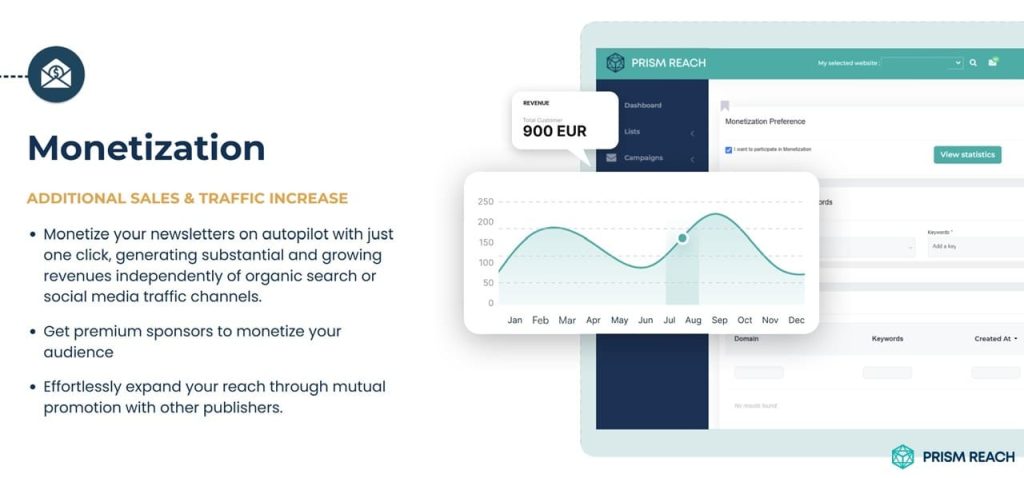
User Journey
The typical user journey with Prism Reach involves a streamlined process where subscribers sign up through a customized form, select their interests, and then receive personalized newsletters that cater specifically to their preferences. This journey not only enhances user satisfaction but also boosts the likelihood of long-term subscriber retention.
Compliance and Data Privacy
Prism Reach emphasizes GDPR compliance and hosts data within Europe, adhering to the highest standards of data protection. This focus on privacy is crucial for building trust with users and complying with international regulations.
Future Prospects
Looking ahead, Prism Reach aims to expand its technology into the eCommerce sector and explore new ways to leverage AI for broader marketing applications. The company is committed to continuous improvement of its AI algorithms, ensuring that its solutions remain at the cutting edge of technology and marketing innovation.
Practical Tips for Enhancing Email Marketing Efficiency
Despite the strengths of Pardot and Marketo, implementing the following practical strategies can help streamline your email marketing efforts and derive quicker, more actionable insights:
1. Leverage Personalization
- Use data to tailor email content to individual preferences and behaviors.
- Implement dynamic content blocks to customize sections of your emails based on user data.
- Utilize tools like Prism Reach to automate and enhance personalization efforts.
2. Incorporate Interactive Elements
- Add quizzes, polls, or surveys to engage recipients and gather valuable feedback.
- Use interactive content to make your emails more engaging and memorable.
- Analyze responses to better understand your audience’s preferences and interests.
3. Implement Hidden Gem Strategies
- Integrate cohort analysis to track subscriber behavior over time.
- Utilize predictive analytics to anticipate subscriber actions and tailor campaigns accordingly.
- Employ attribution modeling to understand the impact of each email on conversions.
Enhancing Email Marketing Strategies with Prism Reach
Integrating Prism Reach into your email marketing strategy can significantly enhance your data analysis and campaign effectiveness. Here are three specific places where screenshots of Prism Reach can be particularly helpful:
- Behavioral Segmentation Dashboard: Visual representation of how Prism Reach segments your audience based on behavior and preferences.
- Predictive Analytics Interface: Showcasing the tools used to forecast subscriber actions and optimize campaign strategies.
- Email Heatmap Visualization: Demonstrating how Prism Reach’s heatmap tool helps in optimizing email layout and content placement.
Benefits of Prism Reach
- Simplified Reporting: Prism Reach offers a clean, intuitive interface that makes it easy to access and interpret key metrics without navigating through a crowded dashboard.
- AI-Powered Insights: The platform’s AI-driven analysis provides actionable insights quickly, enhancing the efficiency of marketing strategies.
- Seamless Integration: With a quick setup process and seamless integration capabilities, Prism Reach minimizes the technical hurdles associated with data synchronization and reporting.
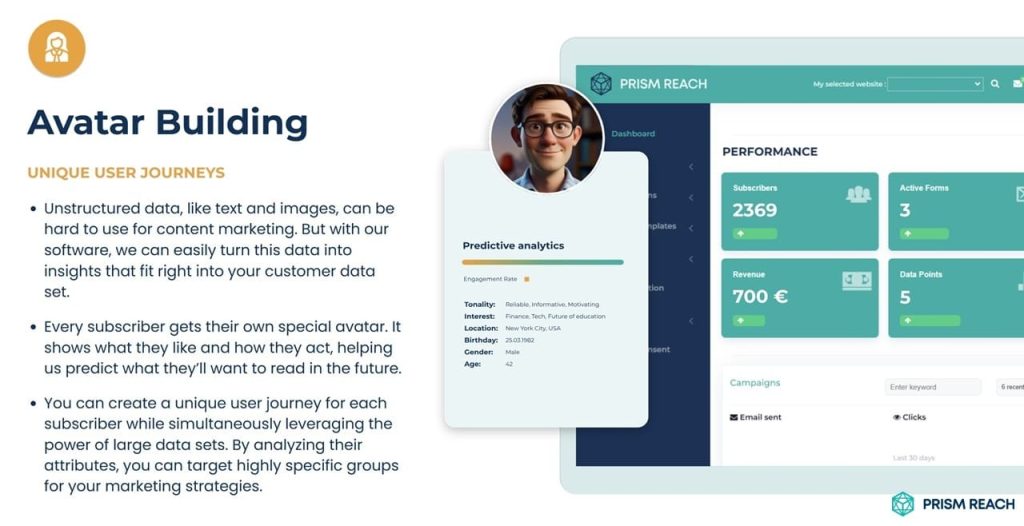
User Journey
The typical user journey with Prism Reach involves a streamlined process where subscribers sign up through a customized form, select their interests, and then receive personalized newsletters that cater specifically to their preferences. This journey not only enhances user satisfaction but also boosts the likelihood of long-term subscriber retention.
Compliance and Data Privacy
Prism Reach emphasizes GDPR compliance and hosts data within Europe, adhering to the highest standards of data protection. This focus on privacy is crucial for building trust with users and complying with international regulations.
Future Prospects
Looking ahead, Prism Reach aims to expand its technology into the eCommerce sector and explore new ways to leverage AI for broader marketing applications. The company is committed to continuous improvement of its AI algorithms, ensuring that its solutions remain at the cutting edge of technology and marketing innovation.
Upgrade Your Email Marketing with AI Personalization!
Conclusion
In the Pardot vs. Marketo comparison, both platforms offer valuable features for email marketing. Pardot stands out for its seamless Salesforce integration and robust lead management capabilities, making it an excellent choice for B2B companies heavily invested in the Salesforce ecosystem. Marketo, with its advanced account-based marketing and comprehensive analytics, caters to larger enterprises with complex marketing needs and the technical resources to fully leverage its capabilities.
Implementing hidden gem strategies such as utilizing progressive profiling, leveraging smart campaigns, implementing automation rules, using hidden fields, and integrating with CRM systems can significantly enhance the effectiveness of marketing automation efforts with both platforms.
Moreover, adopting advanced data analysis techniques like cohort analysis, predictive analytics, and attribution modeling can provide deeper insights and enhance campaign performance. For those seeking a more robust and seamless solution, Prism Reach offers a compelling alternative. With its AI-driven personalization, advanced integration capabilities, and comprehensive data insights, Prism Reach empowers marketers to overcome the limitations of traditional marketing automation tools like Pardot and Marketo.
As the marketing automation landscape continues to evolve, staying informed about platform strengths and integrating innovative solutions will be key to maintaining a competitive edge. By leveraging these hidden gem strategies and utilizing advanced tools like Prism Reach, businesses can create more engaging, personalized, and efficient email marketing campaigns that drive better results and foster stronger customer relationships.
Sources
- Knak Blog. (n.d.). How to Build Effective Forms for Landing Pages.
- Merge World. (n.d.). Comparing Marketing Automation Platforms: Pardot vs. Marketo.
- Trantor Inc. (n.d.). Marketo vs. HubSpot vs. Pardot.
- LinkedIn Articles. (n.d.). Cheat Sheet: Learning Marketo After Pardot (and Vice Versa).
- Sylvain Davril’s Insights. (n.d.). Unlocking Marketo’s Potential Beyond Native Activity.
- SelectHub. (2024, October 9). Pardot vs Marketo: Which Marketing Automation Software is the